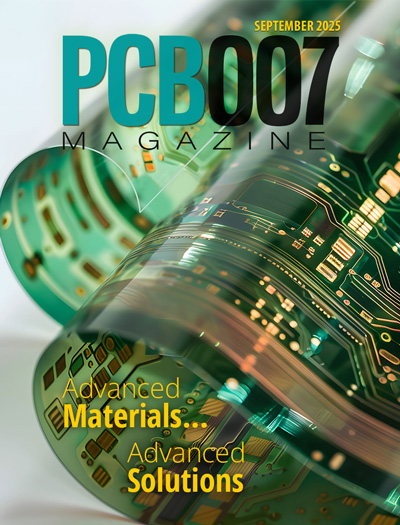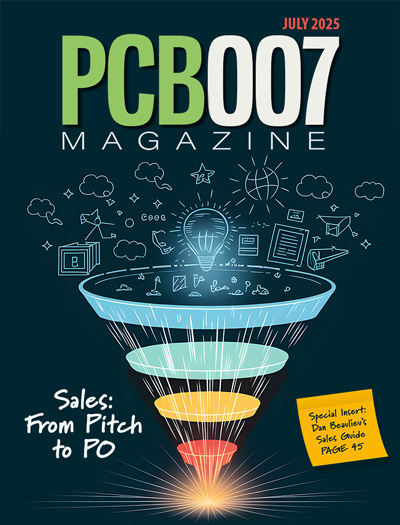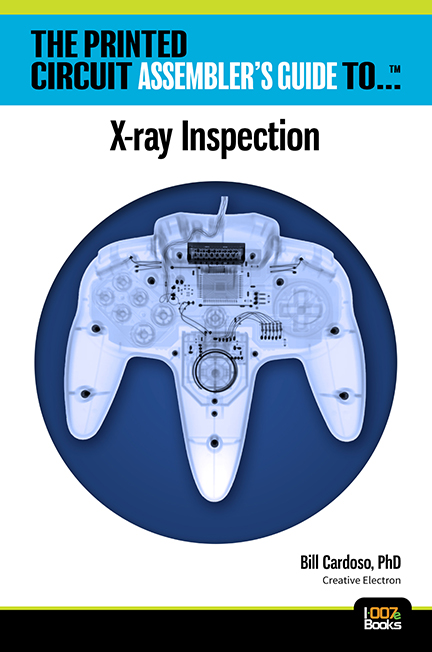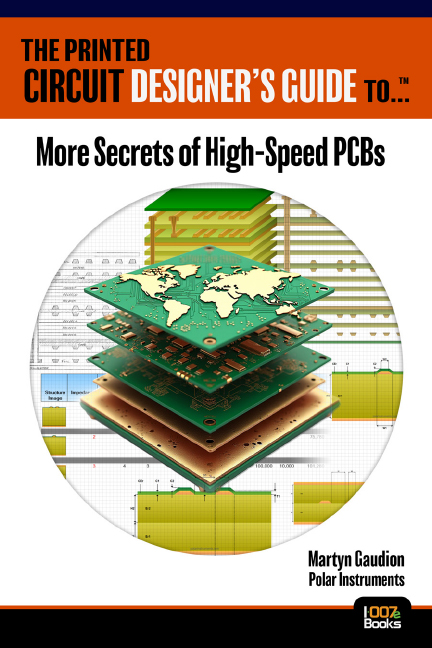-

- News
- Books
Featured Books
- pcb007 Magazine
Latest Issues
Current Issue
Advancing the Advanced Materials Discussion
Moore’s Law is no more, and the advanced material solutions to grapple with this reality are surprising, stunning, and perhaps a bit daunting. Buckle up for a dive into advanced materials and a glimpse into the next chapters of electronics manufacturing.

Inventing the Future With SEL
Two years after launching its state-of-the-art PCB facility, SEL shares lessons in vision, execution, and innovation, plus insights from industry icons and technology leaders shaping the future of PCB fabrication.

Sales: From Pitch to PO
From the first cold call to finally receiving that first purchase order, the July PCB007 Magazine breaks down some critical parts of the sales stack. To up your sales game, read on!
- Articles
- Columns
- Links
- Media kit
||| MENU - pcb007 Magazine
Automated Driving: ZF and Infineon Use AI Algorithms to Optimize Software and Control Units for Driving Dynamics
September 17, 2024 | InfineonEstimated reading time: 4 minutes
Trucks automatically driving behind one another on the highway, 'platooning', or cars automatically changing lanes: Here vehicle movements have to be calculated and executed precisely and quickly without a human driver. Software and AI algorithms safely control the drive, brakes, front and rear wheel steering and damping systems. The more efficient the AI algorithms are, the better the available computing power can be used.
The ZF Group and Infineon Technologies AG (FSE: IFX / OTCQX: IFNNY) have jointly developed and implemented AI algorithms for the development and control of vehicle software as part of the EEmotion project. The project was co-funded by the German Federal Ministry for Economic Affairs and Climate Action. The AI algorithms developed in the project, proven in a test vehicle, control and optimize all actuators during automated driving according to the specified driving trajectory.
ZF has added AI algorithms to its two existing software solutions cubiX and Eco Control 4 ACC, which have been implemented on Infineon’s AURIX™ TC4x microcontroller (MCU) with integrated Parallel Processing Unit (PPU). The result: More efficient artificial intelligence algorithms and better utilization of computing power. This in turn leads to better driving performance and increased driving safety. Compared to conventional approaches without AI, the two companies have now proven that their solution can for example carry out automated lane changes much more accurately. The energy efficiency of driver assistance systems such as Adaptive Cruise Control has also been increased. The improved driving performance combined with lower computing power demands paves the way for cost-efficient Level 2+ assistance systems.
"The EEmotion funding project shows that our artificial intelligence-based algorithms provide our customers with new advantages: AI makes it possible for products to be equipped with new functions and to be developed faster and more efficiently," said Torsten Gollewski, Head of Research and Development at ZF.
“With our world-leading semiconductor products, software and services, Infineon enables customers to develop their own AI applications,” said Peter Schiefer, President of Infineon’s Automotive Division. “Our AURIX TC4x is ideally suited for in-car AI applications because its Parallel Processing Unit enables the fast and parallel processing of data that is essential for artificial intelligence, heralding the next stages of automated and ultimately autonomous driving."
"The EEmotion project successfully integrated artificial intelligence into the safety-critical functions of the vehicle control system; this was validated on the software side, making further progress towards highly automated driving possible," said Ernst Stoeckl-Pukall, Head of the Digitization and Industry 4.0 department at the Federal Ministry for Economic Affairs and Climate Action. "The project has thus provided important impetus that has strengthened the innovative power and competitiveness of the German automotive industry."
Software-based chassis control optimized with AI
ZF's cubiX software makes it possible to control all chassis components in passenger cars and commercial vehicles. This includes longitudinal and lateral dynamics as well as the vehicle's vertical dynamics. In addition, the Eco Control 4 ACC predictive cruise control system is being further developed using a computationally intensive optimization algorithm and model-predictive control to achieve as much as 8 percent more range under real driving conditions. The EEmotion project has also developed AI algorithms which are applied as early as during the development phase. This allows more efficient design of vehicle software which can then be made available to customers more quickly. The accelerated and AI-supported application of vehicle software offers vehicle manufacturers clear advantages when adapting to different vehicle models.
Microcontroller from Infineon enables use of AI algorithms
Lean, AI-based algorithms require a lot of computing power, which makes it advisable to integrate them into high-performance microcontrollers such as the AURIX TC4x. Infineon's AURIX TC4x microcontrollers offer high real-time performance and implement the latest trends in AI modelling, virtualization, functional safety, cybersecurity and networking functions. They pave the way for new E/E architectures and the next generation of Software-Defined Vehicles (SDV). An important part of the AURIX TC4x is the Parallel Processing Unit, which supports powerful AI applications thanks to fast and parallel data processing.
About the EEmotion project
The EEmotion project's objective was to develop an AI algorithm-based control system for automated driving that ensures more precise trajectory control in various driving situations. The implementation of the project included the definition of the requirements for the AI-based functions, the development of an overall concept and corresponding hardware as well as developing the integration of AI in control architectures for safety-critical applications. It also took aspects such as the development of secure AI-monitored communication and the investigation of the simulative development and validation of vehicle dynamics systems into account. Infineon Technologies AG acted as the consortium coordinator for the project, with a total volume of 10.4 million euros, 59 percent of which was funded by the German Federal Ministry for Economic Affairs and Climate Action. The project ran from September 2021 to August 2024 and included partnerships with ZF Friedrichshafen AG, b-plus technologies GmbH, samoconsult GmbH, RWTH Aachen University and the Universität zu Lübeck.
Testimonial
"Our marketing partnership with I-Connect007 is already delivering. Just a day after our press release went live, we received a direct inquiry about our updated products!"
Rachael Temple - AlltematedSuggested Items
STMicroelectronics Sets 20-year Availability for Popular Automotive Microcontrollers
09/08/2025 | STMicroelectronicsSTMicroelectronics has extended the ongoing longevity program for its widely deployed SPC58 automotive microcontrollers (MCUs) from 15 years to 20 years, ensuring availability of general-purpose and high-performance product lines until at least 2038.
Gartner Predicts a $158B Shakeup—ScaleFlux Says the SSD Revolution Has Begun
08/11/2025 | BUSINESS WIREOff-the-shelf SSDs no longer meet the needs of the largest SSD users. Gartner predicts that by 2026, over 30% of on-premises storage will rely on captive NVMe SSDs—up from less than 5% in 2023.
Zero Defects International Partner, Epoch International, Announces Sale on Precision Control Systems
06/21/2025 | Zero Defects InternationalZero Defects International partner, EPOCH INTERNATIONAL, has announced significantly reduced overstock pricing for a large quantity of precision industrial motor, actuator, and sensor control systems.
Microchip Enhances Digital Signal Controller Lineup with Industry-Leading PWM Resolution and ADC Speed
06/21/2025 | MicrochipEvolving security and functional safety demands, coupled with the growing complexity of real-time embedded applications, are driving designers to seek innovative solutions that deliver greater accuracy, improved reliability and compliance with industry standards.
Scanfil Signs New Customer and Starts Manufacturing Control Units for Emerson
06/19/2025 | ScanfilScanfil and Emerson signed an agreement concerning the Rosemount Tank Radar for Advanced Level Measurement Solutions. Emerson is a global technology, software and engineering company domiciled in the USA.


